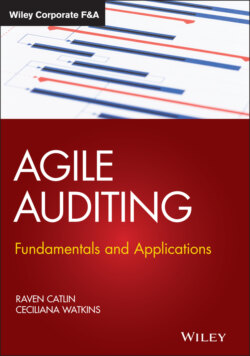Читать книгу Agile Auditing - Raven Catlin - Страница 17
CHAPTER 1 What Is Agile? AGILE IS A FRAMEWORK
ОглавлениеIt felt like a no‐brainer to answer this question, as we set our sights on publishing a book on Agile auditing. Through discovery, we found that Agile has different meanings depending on your view and approach. When you develop and work with Agile, it's vital that you describe what Agile is and what it means.
Authors of other Agile publications describe it as a mindset or a methodology. Agile, for example, in Rick Wright's Agile Auditing: Transforming the Internal Audit Process (Wright 2019), he uses big “A” and little “a” to distinguish between doing Agile and being agile. Used as a noun, Wright refers to the big “A” as doing Agile internal auditing using software development methodologies. Wright's little “a,” used as a verb, describes, in general, process improvement efforts (exclusive of specific methodology) to achieve a nimbler, less wasteful process. Big “A” is essentially the technical aspect of completing an audit. Little “a” is the thinking behind being agile. Being agile is as unique to an organization as your DNA is to you. To do Agile well, you must be agile, so from here on we make no distinction between being Agile and doing Agile. Agile is both a mindset and a framework. We hope that your organization, including your audit team, will demonstrate business agility using Agile methods. Agile organizations identify changes and risks from internal and external sources, respond to those changes promptly and appropriately, deliver value to their customers, and remain sustainable. While this book is a framework providing options to implement Agile auditing, we've also provided various “recipes” with step‐by‐step examples of how to implement the framework. These recipes are as close as we get to prescribing a methodology. Remember, the recipes and the case studies provided in the text are just examples!
Agile is not a methodology itself in any discipline. It is a philosophy, a mindset, or a way of thinking to get stuff done faster based on the interests of identified customers.
It is important to note that Agile is not a methodology itself in any discipline. It is a philosophy, a mindset, or a way of thinking to get stuff done faster based on the interests of identified customers. The roots of Agile as a philosophy originated in software development. It was software developers who combined existing frameworks to create the Agile movement to complete software development projects faster. You can think of Agile as an umbrella term for a set of different frameworks and practices all based on the original software development values and principles. These values are expressed in the “Manifesto for Agile Software Development,” and the 12 principles as fashioned by the Agile Alliance are presented later in this chapter. Another key thought is that Agile methods are people‐oriented rather than process‐oriented. In Agile, people come first and people complete projects. Conversely, conventional project management and software development methods, such as waterfall, are process‐oriented.
Before we continue describing Agile, we want to clarify that there is a time and place for traditional conventional project management methods, such as waterfall. For example, certain mandatory compliance audits with repeated processes year after year might benefit from a waterfall process‐oriented approach. As a matter of fact, although there appears to be a mass adoption of various Agile methodologies in many organizations, there are still many that continue to use conventional methods successfully. We have also seen organizations transition into a hybrid Agile approach that combines aspects of both Agile and waterfall. Our Agile framework was developed specifically to help address common problems that arise when completing all audits using the traditional methodologies (i.e., waterfall).
